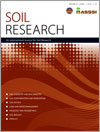SR12243Rill and interrill erodibility and sediment characteristics of clayey Australian Vertosols and a Ferrosol
Erosion models are needed in order to understand soil erosion mechanisms and resulting sediment transport and to determine the best soil conservation practices. Models based on erosion processes are driven by input data. We measured erodibility in rill and interrill areas for three Australian soils with high clay content and found that they were substantially different from the estimated values using proposed equations for the WEPP model. Use of the model outside its US database requires calibration with locally obtained data, which must be obtained experimentally in the field.




